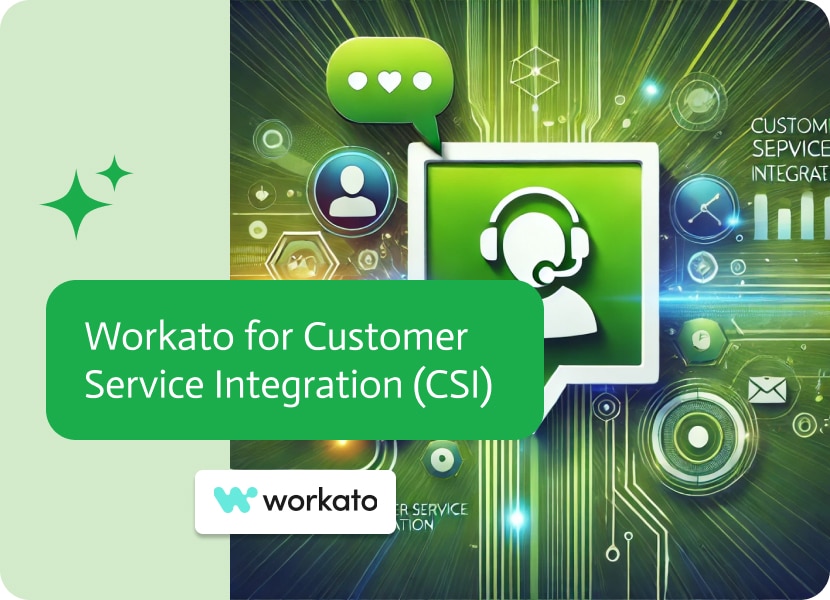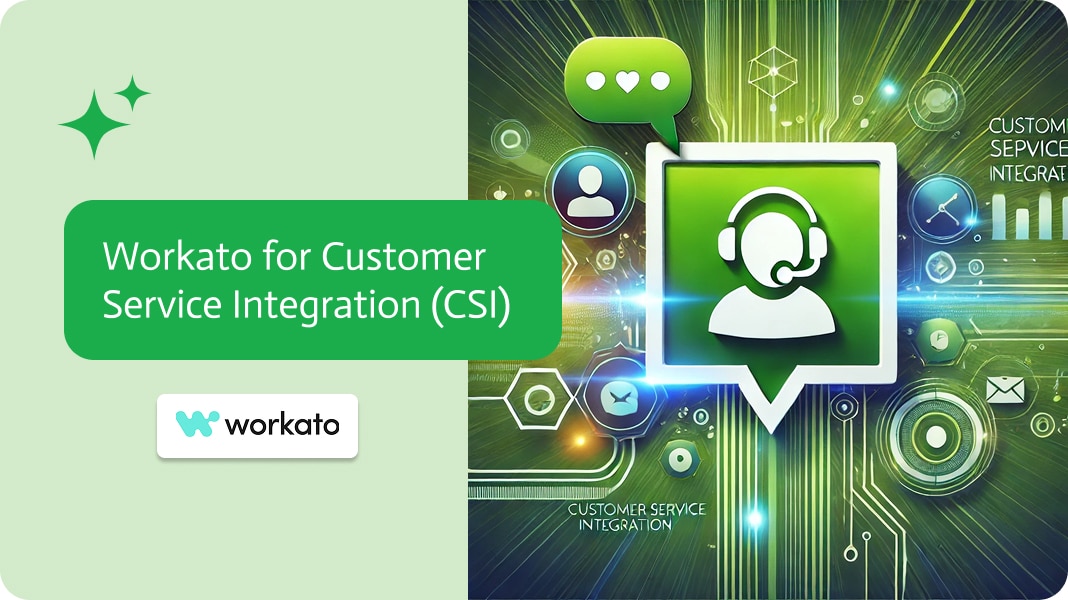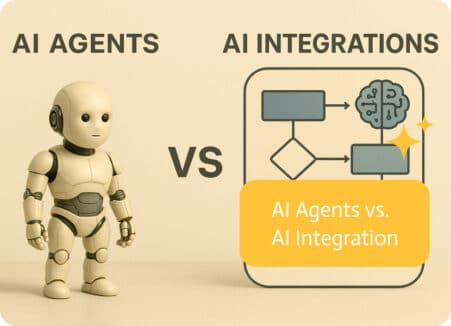

Workato for Customer Service Integration (CSI)
Understanding Workato
Workato is a leading integration platform as a service (iPaaS) that empowers businesses to automate workflows across various applications and systems. By utilizing Workato for Customer Service Integration (CSI), companies can seamlessly connect both cloud and on-premises applications. This platform leverages advanced technology to streamline business processes, enhance efficiency, and improve data integration.
What is Customer Service Integration?
Customer Service Integration involves connecting various customer service and communication tools to create a unified system that enhances team collaboration, centralizes data, and automates workflows. Integrating customer service tools reduces manual effort, improves communication, and enhances operational efficiency by ensuring seamless data flow between tools such as Slack, Microsoft Teams, Zoom, and more.
Top 7 Use Cases for Customer Service Integration
1. Automate Customer Service
Use Case: Implement automation to handle routine customer service tasks, such as ticket assignment, follow-up emails, and responses to common inquiries.
Benefits:
- Streamlined Processes: Automation ensures consistent and efficient handling of routine tasks.
- Reduced Workload: By automating repetitive tasks, customer service agents can focus on more complex and strategic activities.
- Improved Response Times: Automated responses speed up customer interactions, reducing wait times.
- Consistent Service Quality: Automation ensures that responses and actions are consistent and accurate.
Example: A subscription-based service provider automates routine tasks such as ticket assignment, follow-up emails, and customer satisfaction surveys using Workato. This automation ensures that tickets are assigned to the appropriate agents based on predefined criteria, follow-up emails are sent automatically after a support interaction, and surveys are distributed to gather customer feedback. By automating these processes, the support team can focus on resolving issues and improving service quality.
2. Help Desk Software Integration
Use Case: Integrate help desk software with other business applications to streamline ticket management and improve support processes.
Benefits:
- Seamless Ticket Tracking: Automated tracking of support tickets ensures no issues are overlooked.
- Real-time Updates: Immediate updates on ticket status help keep everyone informed.
- Enhanced Collaboration: Improved communication between support teams and other departments.
- Automated Workflows: Routine tasks, such as ticket assignments, are automated to save time and reduce errors.
Example: An IT department in a large corporation integrates their help desk software with project management and communication tools. This integration allows the IT team to automatically create and assign tickets based on incoming support requests, track the progress of each ticket in real-time, and communicate updates to relevant stakeholders. This streamlined approach reduces resolution times and improves the overall quality of IT support.
3. Call Center Integration
Use Case: Connect call center software with CRM and other business tools to enhance customer service operations.
Benefits:
- Centralized Call Records: All call details are stored in a single system for easy access and review.
- Improved Customer Interaction Tracking: Detailed records of customer interactions help improve service quality.
- Enhanced Agent Productivity: Integrated systems reduce the need for agents to switch between multiple platforms.
- Real-time Data Access: Agents have immediate access to the latest customer information.
Example: A financial services company integrates their call center software with their CRM system. This integration ensures that every call made or received is automatically logged in the CRM, along with detailed notes and recordings. Customer service agents can access these records to provide personalized service and follow up on previous interactions, leading to more effective customer support and better client relationships.
4. Chatbot Integration
Use Case: Integrate chatbots with customer service platforms to automate responses and improve customer engagement.
Benefits:
- 24/7 Customer Support: Chatbots can handle inquiries at any time, providing constant service availability.
- Reduced Response Times: Automated responses to common questions reduce wait times for customers.
- Automated Routine Inquiries: Chatbots can handle frequently asked questions, freeing up human agents for more complex issues.
- Enhanced Customer Experience: Immediate responses and consistent service quality improve the customer experience.
Example: An e-commerce business integrates chatbots with their customer service platform to handle common inquiries such as order status, return policies, and product information. Customers can interact with the chatbot at any time, receiving instant responses to their questions. This not only improves the customer experience but also reduces the workload for human agents, allowing them to focus on more complex support tasks.
5. Customer Service Software Integration
Use Case: Connect various customer service software tools to create a unified system for handling customer inquiries and support tickets.
Benefits:
- Centralized Customer Data: All customer information and interactions are stored in one place, making it easy to access and manage.
- Improved Response Times: Faster access to information allows customer service agents to respond more quickly to inquiries.
- Enhanced Customer Satisfaction: Quick and efficient service improves overall customer satisfaction.
- Reduced Manual Data Entry: Automation reduces the need for manual data entry, minimizing errors and saving time.
Example: A telecommunications company integrates their customer service software with their CRM and email platforms. This integration ensures that customer interactions, whether via phone, email, or chat, are logged in one central system. As a result, customer service agents can quickly access all relevant information about a customer’s history, improving their ability to provide timely and informed assistance.
6. Customer Experience Integration
Use Case: Integrate customer experience tools with other business systems to provide a holistic view of customer interactions.
Benefits:
- Unified Customer Data: All customer interactions and feedback are consolidated into one system.
- Improved Customer Insights: Comprehensive data provides deeper insights into customer behavior and preferences.
- Enhanced Personalization: Integrated data allows for more personalized customer interactions.
- Better Decision-Making: Access to complete and accurate data enables more informed business decisions.
Example: A hospitality company integrates their customer feedback tools with their CRM and marketing platforms. This integration allows them to gather and analyze feedback from multiple sources, such as surveys, reviews, and social media. By consolidating this data, the company gains valuable insights into customer preferences and pain points, enabling them to tailor their marketing efforts and improve the overall guest experience.
7. Slack for Customer Service
Use Case: Use Slack as a central hub for managing customer service interactions and collaborating on support issues.
Benefits:
- Real-time Communication: Immediate communication between team members speeds up issue resolution.
- Centralized Information: All customer service interactions and updates are stored in one place.
- Enhanced Collaboration: Team members can easily share information and collaborate on solving customer issues.
- Improved Transparency: Everyone on the team has visibility into ongoing issues and their status.
Example: A software company uses Slack to manage customer service interactions by integrating it with their help desk software and CRM. Support tickets are automatically posted to relevant Slack channels, where team members can discuss and resolve issues in real-time. By centralizing communication and collaboration in Slack, the company improves response times, enhances team coordination, and provides better support to their customers.
Benefits of Workato Customer Service Integration
Leveraging Workato for customer service integration offers substantial benefits for businesses aiming to optimize operations and enhance efficiency. By connecting customer service tools with other business applications, organizations can achieve:
- Efficient Workflows: Automating routine tasks reduces manual labor and minimizes mistakes, allowing teams to focus on strategic activities that drive business growth.
- Operational Excellence: Comprehensive access to business data supports informed decision-making, quicker issue resolution, and a deeper understanding of business needs, resulting in improved productivity and efficiency.
- Accurate Data: Real-time data synchronization ensures information is consistent and up-to-date across all systems, facilitating precise reporting and better decision-making.
- Improved Team Collaboration: Integrating customer service tools with various platforms unifies processes, reduces silos, and promotes collaboration across departments, enhancing overall productivity.
- Valuable Insights: Consolidated data from multiple sources enables advanced analytics and reporting, providing crucial insights into business performance and market trends, which can guide business strategy and foster growth.
Challenges of Workato for Customer Service Integration
While Workato is a robust tool for integrating customer service applications, it presents several challenges that users should consider. Here are some common issues associated with using Workato for customer service integration:
- High Costs: Workato’s pricing structure can be a significant obstacle, particularly for smaller businesses or startups. The costs escalate rapidly with the addition of more integrations, users, and features. This high price point can make Workato less accessible for organizations with limited budgets, forcing them to seek alternative solutions or reduce the scope of their integrations.
- Lack of AI Capabilities: One of the significant drawbacks of Workato is the lack of advanced AI capabilities. Intelligent automation and AI-driven features are increasingly important for enhancing the efficiency and effectiveness of customer service integration. The absence of robust AI functionality in Workato means that many complex tasks still require manual intervention, reducing overall productivity.
- Integration Complexity: Integrating various customer service tools can be complex, especially when dealing with multiple platforms and APIs. Workato’s extensive features, while powerful, can add to this complexity. Users without advanced technical skills will find it challenging to set up and manage integrations effectively.
- Learning Curve: Despite being marketed as a no-code platform, Workato still requires a significant investment in training and learning. Users without technical backgrounds might find it difficult to understand and fully utilize all features, leading to potential underutilization of the platform’s capabilities.
- Limited Real-Time Processing: Effective customer service often depends on real-time data processing. Some users have reported that Workato does not always handle real-time data updates effectively, leading to delays that can negatively impact customer service response times and satisfaction.
- Integration Downtime: In customer service, even minimal downtime can significantly impact customer satisfaction. Some users have reported occasional downtime during integration updates or maintenance, which can disrupt customer service operations and lead to delays in response times.
Understanding these potential challenges can help businesses make informed decisions about using Workato for their customer service integration needs and whether exploring alternative solutions might be more beneficial.
Using Workato for Customer Service Integration
By utilizing platforms like Workato for customer service integration, businesses can seamlessly connect their tools with other essential applications, automate complex workflows, and continuously optimize their operations. However, several other noteworthy alternatives to Workato offer unique features such as user-friendly interfaces, powerful automation capabilities, and advanced data manipulation. Platforms such as Noca AI provide an AI-first and NLP-first approach, enabling intelligent integrations that streamline operations and enhance customer experiences, making them a compelling choice for modern businesses.
Q&A Section
Q: What are customer service automation solutions?
A: Customer service automation solutions are tools and technologies designed to automate routine customer service tasks, such as ticket assignment, follow-up emails, and answering common inquiries. These solutions help improve efficiency, reduce manual effort, and ensure consistent service quality by handling repetitive tasks, allowing human agents to focus on more complex and strategic activities.
Q: How can automating customer service benefit my business?
A: Automating customer service can significantly benefit your business by streamlining operations, reducing response times, and improving service consistency. Automation helps in handling high volumes of inquiries quickly, minimizing errors, and ensuring that customers receive timely and accurate responses. This leads to enhanced customer satisfaction, reduced operational costs, and allows your team to focus on more valuable tasks.
Q: What is 360 customer service?
A: 360 customer service refers to a comprehensive approach to customer support that provides a complete view of the customer’s interactions and history across all touchpoints. This approach integrates data from various channels such as phone, email, chat, and social media, allowing customer service agents to have a holistic understanding of the customer’s needs and preferences, leading to more personalized and effective support.
Q: How does customer service and support automation improve efficiency?
A: Customer service and support automation improve efficiency by automating routine tasks, reducing the need for manual intervention, and ensuring that processes are consistent and error-free. Automation tools can handle tasks such as ticket categorization, routing, and responding to common inquiries, which speeds up resolution times, enhances productivity, and allows support teams to focus on more critical and complex issues.
Q: What are the features of a modern customer service platform?
A: A modern customer service platform includes features such as omnichannel support, real-time analytics, automation capabilities, AI-driven chatbots, and seamless integration with other business systems. These platforms are designed to provide efficient, scalable, and personalized customer service, enabling businesses to meet the demands of today’s customers who expect quick, consistent, and high-quality support across multiple channels.
Q: What is a customer service automation platform, and how does it work?
A: A customer service automation platform is a technology solution that automates various aspects of customer service operations. It works by integrating with existing customer service tools and systems, using predefined rules and AI to handle routine tasks, such as answering FAQs, routing tickets, and providing instant responses to common inquiries. This platform helps improve response times, enhance service consistency, and free up human agents for more complex tasks, ultimately improving overall customer satisfaction


